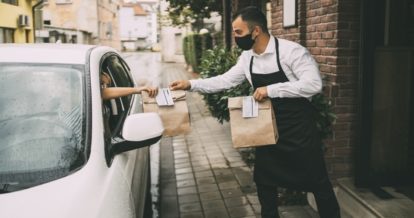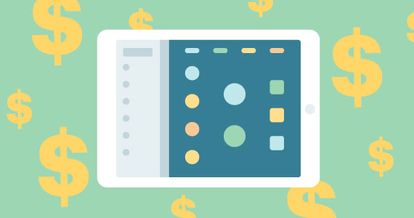The COVID-19 pandemic has dramatically altered the restaurant industry and one of the biggest changes has been the rise of curbside pickup restaurant operations.
In fact, a survey by Bluedot found the use of restaurant curbside pickup has only continued to increase as the pandemic has worn on. As Bluedot reveals, 67% of consumers were using curbside pickup as often or more frequently in January of 2021, compared to 45% in April of 2020.
And while curbside pickup may seem like a major departure from the traditional dining experience, these figures are unsurprising given the many benefits of restaurant curbside pickup. For customers, online ordering and curbside pickup is not just a safe way to visit a restaurant during the pandemic, but it’s also a very convenient way to grab takeout. In most cases, customers don’t even have to get out of their car to collect their order.
And curbside pickup isn’t just popular with customers. Curbside pickup restaurant operations are also great for business because they provide a low-cost way to offer takeout – especially for restaurants without drive-thru ordering systems. And unlike third-party food delivery apps, curbside takeout allows restaurants to offer a quick and convenient takeout option at no extra cost per order.
Whether you’re new to this off-premise restaurant model, or you’re simply looking to optimize your current curbside pickup restaurant setup, this guide will cover everything you need to know, including:
- What is curbside pickup?
- How does curbside pickup work?
- The benefits of curbside pickup for restaurants
- 9 curbside pickup restaurant tips
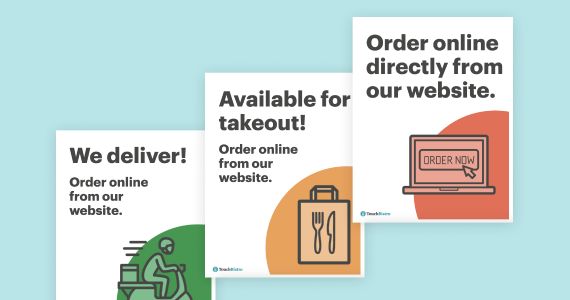
Let your customers know how to order takeout and delivery from you.
What Is Curbside Pickup?
Before diving into our top curbside tips, let’s start with a more basic question: what is curbside pickup?
Curbside pickup is a method of serving takeout that involves staff bringing an order directly to a customer waiting in their car, which is parked at the curb in front of your restaurant (or at another dedicated pickup spot). This model is considered a safe way for customers to pick up takeout orders from restaurants because it allows staff and customers to maintain a safe distance from one another.
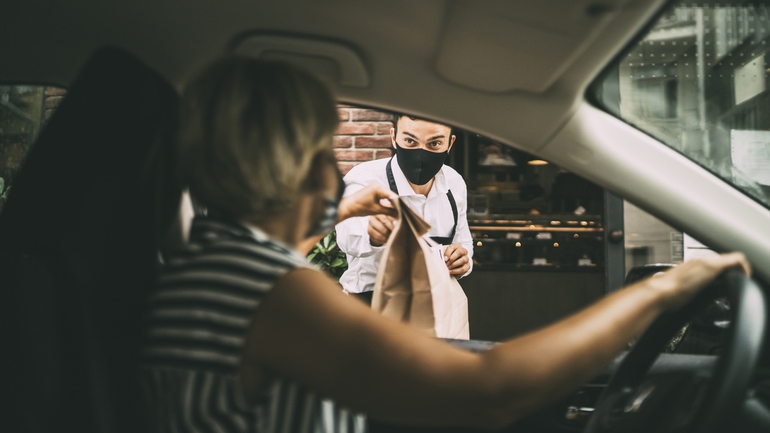
How Does Curbside Pickup Work?
Though curbside pickup has taken on new meaning in the past few years, the idea originally started with drive-in restaurants with carhops, where staff would serve and bring out food to guests waiting in the comfort of their cars. Now, this midcentury model is providing a perfect template for takeout in the COVID-19 era.
So how does curbside pickup work today?
Though it differs from restaurant to restaurant, generally curbside pickup starts with a customer placing an order for takeout by phoning the restaurant, or by using an online ordering system or app. After the order has been confirmed, the customer drives to the restaurant and waits in a designated spot for staff to bring their order out. If the restaurant is using a digital order system, the customer can confirm when they’ve arrived so staff knows exactly when to bring the order out.
No matter what curbside pickup looks like at your restaurant, this simple setup comes with a lot of benefits for both restaurants and customers:
- It’s a safer way to offer takeout: Curbside pickup eliminates the need for customers to go inside your restaurant or come in close contact with staff, thereby reducing the possible transmission of the coronavirus.
- It’s convenient for customers: Instead of waiting on delivery, customers can do the driving themselves and quickly pick up a meal to go. Research by Deloitte found that diners are especially interested in curbside pickup if the restaurant is within a 10-mile radius of their home because it’s likely to be faster than delivery.
- It opens up an off-premise revenue stream for restaurants: For restaurants that can’t offer dine-in service (or can only do so at a reduced capacity), curbside pickup allows restaurants to bring in valuable revenue from takeout orders.
- It reduces the need to rely on third-party apps: Curbside pickup can be done entirely in-house with little overhead costs, allowing restaurants to bring in revenue from off-premise orders without relying on pricey third-party apps.

Let your customers know how to order takeout and delivery from you.
9 Curbside Pickup Restaurant Tips
Setting up your own curbside pickup restaurant operation may seem fairly straightforward, but there are some strategies you can use to make your setup more efficient and successful. Below are nine restaurant curbside pickup tips to try.
1. Create a Curbside Takeout Menu
Before you begin offering curbside pickup, you’ve got to create a dedicated curbside takeout menu. Though it may seem easier to simply offer your full menu, creating a small menu specifically for curbside pickup will help you streamline your kitchen operations and ensure you don’t sacrifice quality when packaging meals to go.
To curate the perfect curbside pickup food menu, keep the following tips in mind:
- Offer a limited number of dishes: Speed is key to a great takeout experience, so keep your menu on the small side so your back-of-house staff can focus on quickly preparing just a few dishes.
- Stick to your most popular dishes: Customers will be more inclined to make the trip to your restaurant if they know they can get their favorites, so make sure your curbside pickup food menu includes your best-sellers.
- Remove items that don’t travel well: Curbside pickup means that some customers may be driving quite a distance to pick up your food. Ensure that their meal can go the distance by using the right takeout food packaging and only serving dishes that hold up well in transit.
- Sell alcohol (if you can): Alcohol boasts high profit margins and travels well. If alcohol delivery and pickup is legal in your area, consider including to-go drinks alongside your food menu.
- Get creative: Consider expanding your curbside takeout menu to include family packs, ready-to-cook meal kits, or even pantry staples. These creative offerings can set your restaurant apart from the competition and help boost check sizes.
2. Select Appropriate Takeout Packaging
When you package orders for delivery, you can usually count on couriers to have warming bags that keep things hot. However, this is not the case when it comes to curbside takeout.
To keep curbside pickup food orders safe, secure, and at the right temperature, keep the following in mind:
- Select the appropriate container for each item: Whether it’s plastic, cardboard, styrofoam, or a biodegradable material, choose food packaging that makes sure hot items stay hot, cold items stay cold, and liquids stay in containers. You might also consider adding tamper-evident labels to give customers peace of mind.
- Stay on brand: Your takeout packaging is valuable real estate for your brand. Make sure to include your company name or logo on the packaging so that your brand is visible to anyone who sees it.
- Include utensils, napkins, and condiments: Some diners may want to eat immediately in their car, so make sure you include everything needed for a full dining experience.
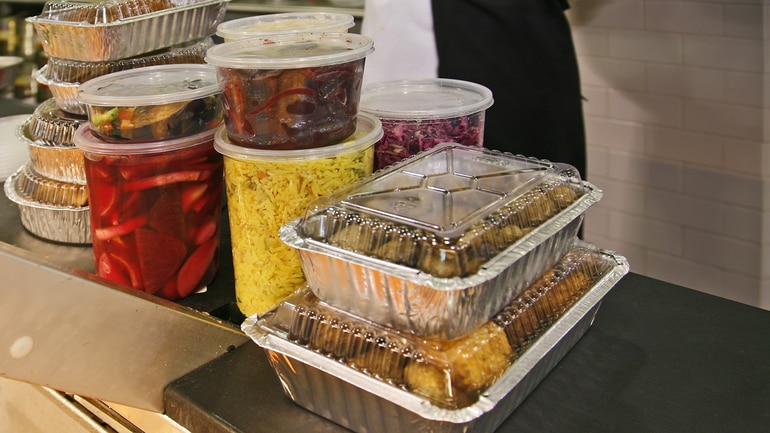
3. Implement Online Ordering
Once you’ve decided on your curbside takeout menu, you need a way for customers to actually order curbside pickup. The easiest way to do this is by implementing an online ordering system.
An online ordering system allows customers to view your takeout menu, place an order, and pay, all from your website. And if you use a platform like TouchBistro Online Ordering, all these online orders will be streamlined directly into your POS so there’s no need for manual order entry and the kitchen can begin preparing orders as soon as they come in.
Similar to a direct online ordering system, you can also use certain third-party apps to accept curbside pickup orders. While these apps are relatively easy to set up and use, you will have to pay a hefty commission fee on each order. Moreover, research by Sense360 has shown that the majority of consumers (63%) actually prefer to place their orders directly with restaurants, versus just 18% who prefer to use third parties.
You can also choose to take curbside pickup orders over the phone. However, you’ll be limiting the number of customers you can serve at one time. Not to mention, every order you take over the phone will need to be manually entered into your POS by staff – a process that’s time-consuming and error-prone.

Let your customers know how to order takeout and delivery from you.
4. Create a Dedicated Curbside Pickup Spot
While some venues have the luxury of a quiet street with plenty of curbside parking, this isn’t the case for every restaurant. This means you might have to get a bit creative when it comes to your curbside pickup spot.
If your restaurant has its own parking lot, you can use traffic cones or other markers to create a dedicated spot where customers can wait for their curbside orders. Make sure this spot provides plenty of visibility between your staff and your customers, and is located in an area that’s convenient enough to serve customers quickly.
If there is no parking lot available to your customers, consider contacting your local authorities to request permission to set up temporary parking in front of your business. If this isn’t an option, choose a dedicated pickup spot and provide clear instructions to customers about where they should wait. For instance, it might make sense for customers to park on the street behind your business while they wait for their order, instead of out front. Just make sure you have a procedure in place for customers to let you know when they’ve arrived.
5. Provide Customers with Clear Pickup Instructions
The key to successful curbside pickup restaurant operations is making sure customers know where to go and what to do to collect their orders.
When creating pickup instructions for customers, make sure to address each stage in the process:
Placing an Order
Let customers know exactly where to place an order for curbside pickup – whether that’s directly on your website, through a third-party app, or by phoning you directly. If you’re not using a restaurant online ordering system that lets you digitally communicate with customers, you might want to ask the customer to provide information about their car upfront so staff can easily identify them when they arrive.
Pickup Timing
Once customers have placed their order, give them an estimate of when it will be ready so they can time their arrival accordingly. If you’re using an online ordering system or app, the system can be used to send a confirmation email or SMS text to the customer to let them know when their order is ready.
Parking
Let customers know exactly where to park while they wait for their curbside pickup food order – whether that’s a parking lot, the curbside, or another location.
Identifying Customers
Make sure customers have a way of letting you know they’ve arrived. They may be able to do this through an app, or by calling or texting your restaurant directly. Identifying customers quickly is crucial as a Bluedot survey found that consumer willingness to wait for orders has dropped from 10 minutes to just 6 minutes during the pandemic.
Contactless Handoff
Develop a procedure for contactless hand-off. This might involve asking the customer to pop their trunk so staff can place food directly in the vehicle, or staff may need to hand the order through the car window or door. Whatever method you choose, try to limit face-to-face contact between staff and customers as much as possible.
Payment
If you’re using an online ordering system or a third-party app, you can collect payment when the customer initially places their order. However, the customer isn’t paying in advance, you’ll need to bring payment terminals out to your pickup spot to collect payment.

Let your customers know how to order takeout and delivery from you.
6. Use Contactless Payments
As mentioned above, most online ordering systems or third-party apps allow customers to pay for curbside pickup orders in advance. This is ideal because there’s less need for staff to interact with customers upon pickup.
However, if you’re taking orders over the phone or your online ordering system isn’t set up for online payments, you’ll have to collect payments when customers arrive to collect their orders. In this case, it’s worth investing in credit card readers that allow you to accept contactless payments. With contactless payments, customers simply need to hover their card or mobile wallet app over the payment terminal to complete the transaction – no need to input their card or touch a PIN pad.
Contactless payments are ideal for curbside pickup because they are not only a more sanitary way for customers to pay, but they are also significantly faster. Visa has found that contactless transactions take as little as half a second to process, which is seven times faster than guests paying by chip card and PIN. And when you’re processing a high volume of orders, this time saved can translate into smoother restaurant curbside pickup operations.
7. Train Staff for Curbside Pickup
You may have provided your customers with clear instructions for curbside pickup, but what about your staff?
First and foremost, you’ll need to set up new workflows for your front-of-house and back-of-house staff. Kitchen staff will need to monitor your kitchen order system to keep an eye on incoming curbside takeout orders, while front-of-house staff will need to coordinate the handoff of orders and take payments when necessary.
Depending on the volume of curbside pickup orders, you may want to have a dedicated staff member in charge of coordinating curbside service.
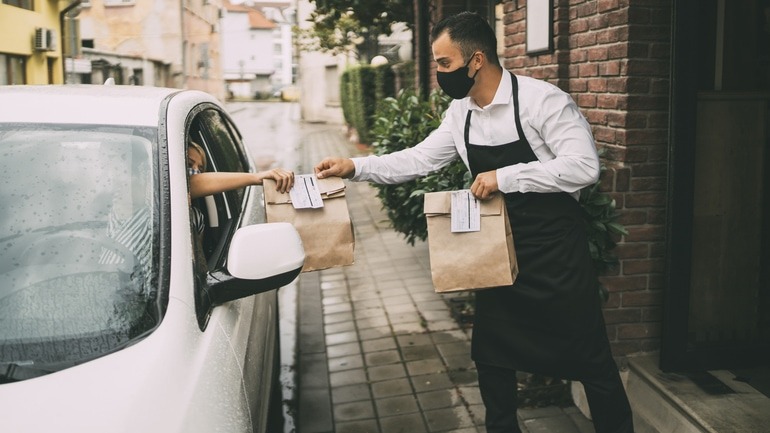
8. Follow Proper Food Safety and Sanitization Procedures
One of the primary reasons curbside pickup has become so popular during the pandemic is because it offers a safer way for customers to enjoy their favorite restaurant dishes.
To ensure your curbside pickup restaurant operations keep everyone safe, keep the following in mind:
- Limit food handling and enforce rigid food safety guidelines: Provide staff with a refresher on personal hygiene, sanitation, food safety, allergens, and food temperature guidelines.
- Equip staff with proper personal protective equipment (PPE): All staff should be wearing face masks, and gloves should be worn when necessary.
- Enforce strict handwashing procedures: Make it easy for staff to wash their hands between each order and make hand sanitizer easily accessible.
- Disinfect high-touch surfaces: Clean high-touch surfaces like your credit card readers between each customer.
And don’t keep your restaurant cleaning a secret; let your customers know how hard you’re working to keep things sanitary and safe. Even before the pandemic, 75% of diners said they would steer clear of a restaurant with bad reviews of its cleanliness. Now cleanliness is even more important to customers so let the public know exactly what steps you’re taking to keep them safe by including information on your website, social media, or even alongside each order confirmation.
9. Promote Your Curbside Pickup Option
After doing all the work of setting up a great curbside pickup experience, you want to make sure your customers actually know about it!
From social media to restaurant signage, here are the best ways to advertise your curbside takeout business:
- In-store signage: Create signs or banners for the front of your restaurant that let passersby know exactly how to order takeout from you. You can even use these ready-made online ordering signs to get started.
- Online profiles: Your website is one of the first places customers will go to try and place an order so make sure you list curbside pickup as an option. You should also advertise curbside pickup across your social media profiles and on your Google My Business listing.
- Email: If you have an email list of existing customers, send out an email explaining your new curbside pickup option and include a link to your takeout menu. If you have a restaurant reward program in place, you might consider creating a dedicated email campaign or promotion for your VIPs.
- Word of mouth: If customers come in for takeout or call for delivery, use this as an opportunity to let them know you also offer curbside pickup.

Let your customers know how to order takeout and delivery from you.
While the pandemic may have accelerated the adoption of curbside pickup restaurant operations, the ease and convenience of this model mean that it could end up being a good source of off-premise revenue in the long run. And by following the above tips, you can ensure your curbside operations are not just efficient, but also profitable.
Free online ordering signs for your restaurant
Sign up for our free weekly TouchBistro Newsletter

